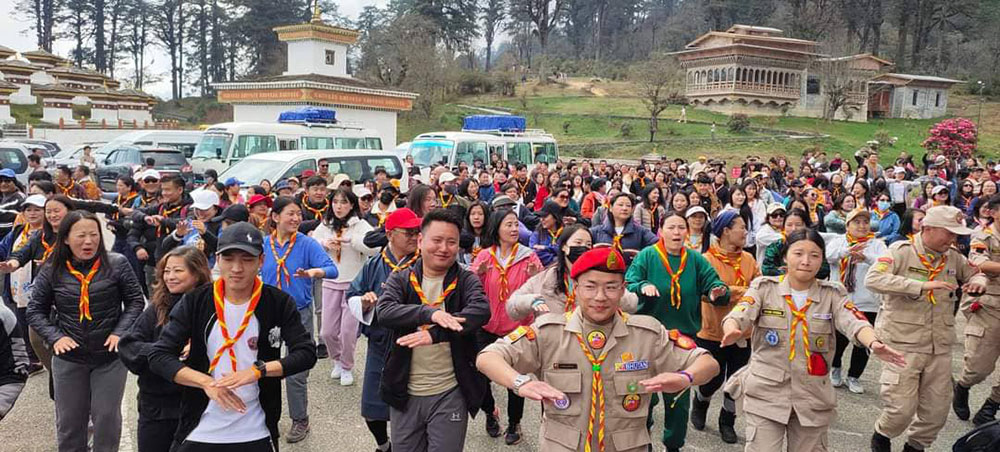YK Poudel
Saturday, April 13—Chimi Tenzin, 41, a teacher of Lungtenphu Middle Secondary School prepared his hiking gears, neatly dressed with a scarf around his neck and rushed towards Lungtenzampa bus terminal for 10 Kilometres Trans-Bhutan-Trail (TBT) walk.
“By 8:30 am, 11 buses adjusting 350 participants drove towards Dochula pass for the TBT walk—which ended by 5 pm,” Chimi Tenzin said.
He was among a troop of other scout participants including school principals, adult scout leaders, staff and youth leaders of 35 schools under Thimphu Thromde. Of the total participants, 200 were females and 150 males.
It is an annual event coordinated as one of the main programmes with the support from Bhutan Scouts Association (BSA).
This programme was instituted at the national level by the Trans Bhutan Trail Office in 2022.
Dorji Gyeltshen, secretary of Thimphu Thromde Scouts Association, said that the TBT has drawn the interest of scouts due to its unique and challenging terrain, natural landscapes and the opportunity for cultural immersion which are among the many core values in scouting.
“The TBT provides scouts with an opportunity to engage in outdoor activities, develop lifelong skills and an adventurous experience,” Dorji Gyeltshen said.
The motive behind, he said, is to revive usage of the ancient route from Dochula to Yusipang—foster a sense of community vitality and explore biodiversity of the particular place.
Similarly, Chimi Tenzin said that the involvement of tourists at Dochula for the warm-up session was an interesting beginning. “The plan of one-week immersion programme for Gyalsups where they will get to travel across the country is a commendable concept as a part of the training,” he said.
“Along the way, at various locations scouting yells and dances were performed, giving a new experience for many,” he said. “The walk specifically served as a networking session for scouts under Thimphu Thromde and discussed scouting plans in their respective schools—which other schools can inculcate.”
“Back in 2022, I took part in the 403 Kms TBT walk between Haa and Trashigang which was tough. The trail now, has been well maintained, trekked by the tourists and is worth exploring,” he said.
Trans Bhutan Trail
The TBT, an ancient 403 Kms trail passes through Haa, Paro, Thimphu, Punakha, Wangdue, Trongsa, Bumthang, Mongar, and Trashigang—taking approximately 36 days. However, people can opt to take different trails within the nine dzongkhags.
Tshering Dolkar, executive director of TBT, said that the trail freely accessible for all has gained international awareness, garnering regional and international tourists.
“TBT connects the trekkers with the local community. As it passes through the local communities across nine dzongkhags. One can gain exposure on Bhutanese culture and traditions along with the health benefits of being in nature,” she said.
As the trail is free for all, there is no exact count of the trekkers.
Tshering Dolkar, executive director of TBT, said that the trail freely accessible for all has gained international awareness, garnering regional and international tourists.
“TBT connects the trekkers with the local community. As it passes through the local communities across nine dzongkhags. One can gain exposure on Bhutanese culture and traditions along with the health benefits of being in nature,” she said.
As the trail is free for all, there is no exact count of the trekkers.
Tshering Dolkar, executive director of TBT, said that the trail freely accessible for all has gained international awareness, garnering regional and international tourists.
“TBT connects the trekkers with the local community. As it passes through the local communities across nine dzongkhags. One can gain exposure on Bhutanese culture and traditions along with the health benefits of being in nature,” she said.
As the trail is free for all, there is no exact count of the trekkers.
The trail passes through 27 gewogs, 12 mountain passes, five suspension bridges, and 10 cantilever bridges, and can visit 21 temples, 77 choetens, and 30 stupas.
Scouting
Globally, the scouting movement has over 57 million members—in 1960s the programme was introduced in Bhutan.
It was introduced in the 1960s under the command of His Majesty The King, Jigme Singye Wangchuck.
Nawang Gyaltshen, deputy chief programme officer, Scouts and Sports Division, Department of Education Programmes, said that Bhutan Scouts Association (BSA) aims to achieve 100 percent school enrolment by 2030.
“The whole-school approach, initiated in 2013, has resulted in over 82 percent of school children joining the scouting movement, impacting Bhutan’s educational landscape,” he said. “Bhutan has received high membership growth awards from Asia-Pacific Region Support Centre for three consecutive years.”
As of 2023 data, there are 131,876 scouts (64,868 male and 67,008 female)—under five different scouting sections.


